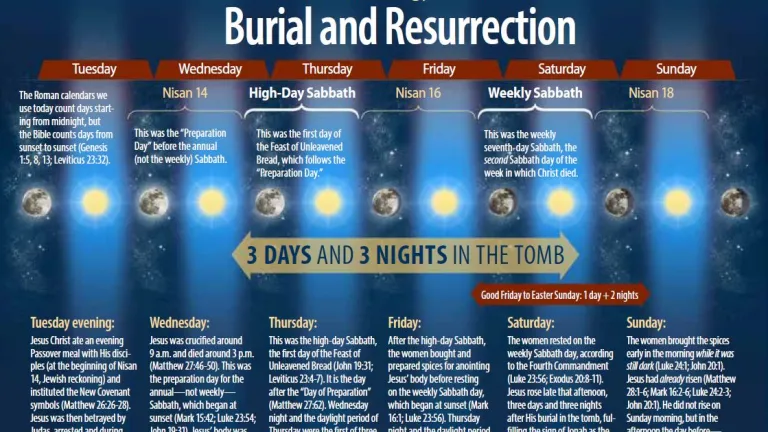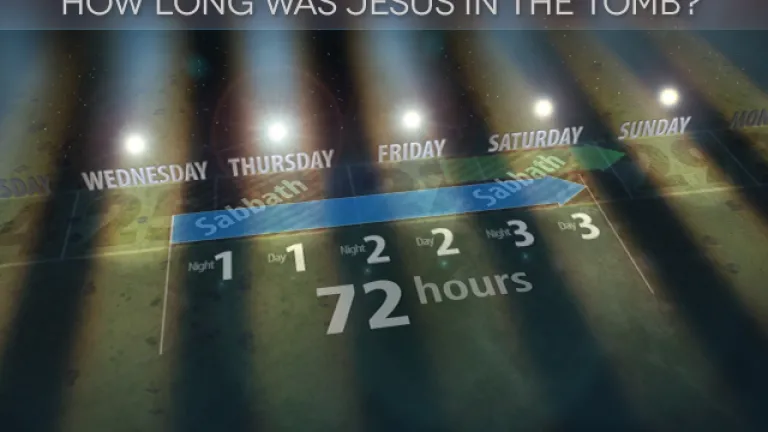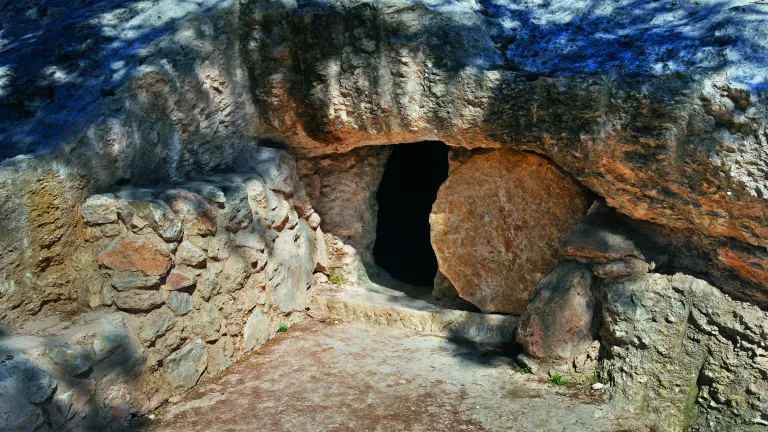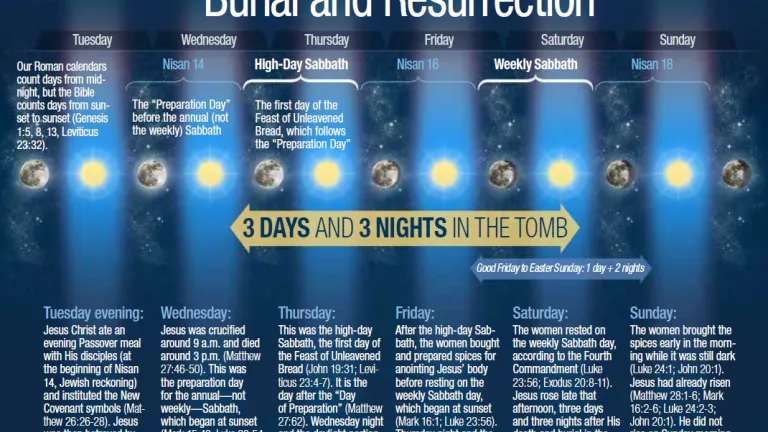Three Days and Three Nights: Did Jesus Keep His Word?

Jesus foretold the length of time He would be in the grave as a sign that He was the Messiah. But that time simply doesn't fit between a supposed Good Friday crucifixion and burial and an Easter Sunday resurrection. What does the Bible actually tell us?
Easter Sunday is the most attended church service of the year. People believe it celebrates Jesus' resurrection. But did you realize there's a major contradiction in the Easter story?
Most believe that Jesus was crucified and placed in the tomb on a Friday afternoon—and then raised back to life on Easter Sunday. But when you compare that to what Jesus Christ Himself said, you'll find there's a major discrepancy, as we'll see.
This is important to understand. Grasping the facts may transform your perspective and even lead you to no longer observe the Easter holiday. Yet it should actually enhance your faith in the death and resurrection of Jesus Christ and bring you to truly honor that as God desires.
This major discrepancy between religion and the Bible, between Christianity and Christ, over Jesus' resurrection is a very serious matter.
What does the Bible actually say about how long Jesus would be in the tomb? Does Scripture itself give contradictory information? Could identifying and understanding the discrepancy affect what you believe and even impact your eternal life?
A sign recalling a great fish
Did you know that people demanded a miraculous sign from Jesus to prove He truly was the Messiah? They wouldn't trust He was Savior without proof: "Then some of the scribes and Pharisees said to Him, Teacher, we desire to see a sign or miracle from You [proving that You are what You claim to be]" (Matthew 12:38, Amplified Bible, brackets in original).
Jesus told them there would be one proof for them—one miraculous sign. What would verify that Jesus was the Christ, the true Messiah, God in the flesh?
"Jesus answered, 'Evil and sinful people are the ones who want to see a miracle for a sign. But no sign will be given to them, except the sign of the prophet Jonah'" (Matthew 12:39, New Century Version, emphasis added throughout).
What was the sign of Jonah? Jesus goes on to explain: "For as Jonah was three days and three nights in the belly of the great fish, so will the Son of Man be three days and three nights in the heart of the earth" (Matthew 12:40).
That was the sign—the one and only proof that Jesus gave to show them He was the promised Savior. But there's a dilemma—a clash between what He said and what most Christians believe and practice. Again, Jesus said, quoting a different translation: "Jonah was in the stomach of the big fish for three days and three nights. In the same way, the Son of Man will be in the grave three days and three nights" (Matthew 12:40, NCV).
That seems pretty straightforward, doesn't it? But here's the problem: How does a Good Friday crucifixion and an Easter Sunday resurrection match with what Jesus said is the one proof that's He's the Savior? This traditional view would place Jesus in the grave for only a day and a half—not three days and three nights.
Counting conundrum from Friday to Sunday
The Bible is clear. After Jesus died, His body was quickly placed in the tomb late in the day, just before sundown when a Sabbath began (as all biblical days are counted from sunset to sunset—see Genesis 1:5, Genesis 1:8, Genesis 1:13; Leviticus 23:32).
Notice John 19: "Therefore, because it was the Preparation Day, that the bodies should not remain on the cross on the Sabbath (for that Sabbath was a high day), the Jews asked Pilate that their legs might be broken [to cause death quickly], and that they might be taken away . . . But when they came to Jesus and saw that He was already dead, they did not break His legs" (John 19:31, John 19:33).
Soon after, His body was taken down and placed in a tomb close to where He was crucified: "So there they laid Jesus, because of the Jews' Preparation Day, for the tomb was nearby" (John 19:42).
Did you catch the apparent contradiction in the story?
It's based on the Preparation Day being the day before a Sabbath—and the weekly Sabbath always falling from Friday sunset to Saturday sunset. Thus many believe Jesus to have been crucified and buried on a Friday—often called Good Friday.
Consider now Jesus' sign of three days and three nights in the grave before being resurrected. If He was in the grave on Friday night, that's one night. And then the daylight part of Saturday is one day. Then Saturday night is two nights. And then Sunday morning He was supposed to be resurrected, which would seem to total two days and two nights. So it doesn't add up!
All we have to do to see the problem is count correctly. Add the days and nights between a late-afternoon Good Friday burial to an Easter Sunday morning resurrection, and it doesn't compute. For Jesus said the proof that He was the Messiah was that He would be in the tomb three days and three nights.
Something's obviously wrong with the traditional Good Friday-Easter Sunday timing. It simply doesn't work, no matter how you try. But if these days don't add up scripturally, then we don't have a Savior.
Reinterpreting as parts of days still doesn't work
Most theologians, religious scholars, pastors and priests know this is a problem. What do they do about it? Most try to work around the conflict by arguing that any part of a day or night could count as a full day or night.
The next step is then typically to argue that the final few minutes of Friday afternoon were the first day, Friday night was the first night, all day Saturday was the second day, Saturday night was the second night and then the first few minutes of Sunday morning were the third day.
That might sound reasonable, but wait. It still doesn't work. This adds up to three days and only two nights, not three days and three nights like Jesus said.
There's another problem, too. John 20 tells us that "on the first day of the week Mary Magdalene went to the tomb early, while it was still dark, and saw that the stone had been taken away from the tomb" (John 20:1).
Did you catch it? The Bible says it was still dark when Mary went to the tomb on Sunday morning and found it empty. Jesus was already resurrected well before daybreak. Therefore, He wasn't in the tomb for any of the daylight portion of Sunday, so none of that can be counted as a day.
That leaves us with, at the very most, part of a day on Friday, all of Friday night, a whole daylight portion on Saturday, and most of Saturday night. That totals one full day and part of another, and one full night and most of another—which is still at least a full day and a full night short of the time Jesus said He would be in the tomb. Once again, it doesn't add up!
What the Bible actually reveals
We know we can't fit three days and three nights between a Friday afternoon crucifixion and Easter Sunday. So what is the truth? When was Jesus crucified and resurrected?
Here are the facts from your Bible: Jesus was actually crucified on a Wednesday and was resurrected near the end of Saturday, the weekly Sabbath. You can verify this, but it's going to take an open mind and an open Bible.
Now let's note something surprising: The week in which Jesus was crucified actually had two Sabbaths in it. Remember John 19:31? It tells us, "Therefore, because it was the Preparation Day, that the bodies should not remain on the cross on the Sabbath (for that Sabbath was a high day)."
Again, most think this is talking about the regular weekly Sabbath day, observed from Friday sunset to Saturday sunset, which is why most assume Jesus died and was buried on a Friday. But that's not accurate.
The Bible refers to two kinds of Sabbath days—the normal weekly Sabbath day, which falls on the seventh day of the week, and seven annual Sabbath days, which each come once a year and can fall on any day of the week (all listed in Leviticus 23).
The Sabbath that began at sundown immediately after Jesus was entombed was one of these annual Sabbath days. The day before wasn't a Friday at all. As we just saw noted in John 19:31, John tells us "that Sabbath was a high day." That's a term used to show the difference between the seven annual Sabbaths—high days—and the regular weekly Sabbath day.
So what was this "high day" that came at sunset right after Jesus was buried?
Jesus kept the annual Passover with His disciples (Matthew 26:18; Luke 22:52), then was arrested later that night. The next morning, still the Passover day, He was crucified. After dying around 3 p.m., He was later placed in the tomb before the day ended, just as the sun was setting to begin the "high day." That high Sabbath day had to be the first day of the Feast of Unleavened Bread, which immediately follows the Passover. You can read about it yourself in Leviticus 23:5-7.
The annual first Holy Day of Unleavened Bread that year was observed from Wednesday sunset until Thursday sunset. Then from Friday sunset to Saturday sunset the normal weekly Sabbath was observed.
So let's see if the math works out:
• Wednesday sunset to Thursday sunset is one day and one night.
• Adding Thursday sunset to Friday sunset makes two days and two nights.
• Then adding Friday sunset to Saturday sunset makes three days and three nights.
• It does add up!
Jesus Christ was in the grave three days and three nights—just as He said. He came back to life at the exact time He foretold He would. The angel at the empty tomb confirmed it: "Do not be afraid, for I know that you are looking for Jesus, who was crucified. He is not here; he has risen, just as he said" (Matthew 28:5-6, New International Version).
Does it matter—what's at stake?
Biblical evidence reveals that the Good Friday-Easter Sunday tradition just doesn't figure. To claim that it's valid and that Jesus' statement about three days and three nights is not valid amounts to a denial of Christ. If we don't believe what Jesus said, or if we try to give it our own interpretation that doesn't agree with what He said, isn't that exactly what we're doing? We'd be saying that Jesus didn't know what He was talking about—that the only sign He said would prove He was the Messiah was either a mistake or a lie.
Sadly, many erroneously believe that the weekly day of worship was changed for Christians from the Saturday Sabbath to Sunday because Jesus was resurrected on Sunday. But He was not, as we've seen, and the change in worship day was more about conforming to pagan practices and gnostic ideas. God tells us to come out of this false worship system (Revelation 18:4).
We hope you'll take a look at the details recorded in the Bible and compare your practice with Jesus' own words. Our worship must be based on truth. Jesus said that "true worshipers will worship the Father in spirit and truth; for the Father is seeking such to worship Him" (John 4:23).
So should this change your life? Should it change the way you worship? Don't you want to worship God in the way He appreciates—the correct way? Then it really does matter. You don't want to be like those Christ described as practicing a useless or vain way of worship (Matthew 15:8).
Isn't it time to be sure that what you believe and practice is based in the Word of God? Make the commitment to worship God according to biblical truth rather than human tradition!
You'll need to take the time to look into the Holy Bible and really get to know the true God. Honor Him the way He wants to be honored, not through the traditions of manmade holidays like Easter and weekly Sunday observance.
Instead, worship Him on His days—the weekly and annual Sabbaths He instituted. Check out the Holy Days of God, the true biblical days of worship, and truly follow Christ. Read your Bible and discover them for yourself!







